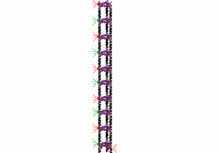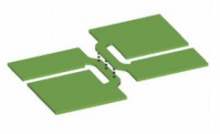
Infectious diseases and respiratory infections in particular are a leading cause of global mortality. As such, there is an urgent need for rapid, large-scale diagnostic tools that can detect these diseases early, something which doesn’t currently exist. To address these problems, McGill University Professor of Bioengineering Sara Mahshid’s lab has developed an all-in-one detection platform (QolorEX) that can deliver test results in just 13 minutes.

A new type of “lab on a chip” developed by McGill University scientists has the potential to become a clinical tool capable of detecting very small quantities of disease-causing bacteria in just minutes.
The device designed by Sara Mahshid, Assistant Professor in the Department of Bioengineering at McGill, is made of nano-sized “islands,” about one tenth of the thickness of a single human hair, which act as bacterial traps or snares.
A team of researchers in the Netherlands has developed the means to store data at the atomic level. This technique would allow 502 terabytes of data to fit into one square inch. According to the authors, "[t]ranslating the two-dimensional storage density presented here to three dimensions, would ... allow the storage of the entire US Library of Congress in a cube 100 µm wide." At the moment, the memory array can operate up to a temperature of 77 K (about -210 C), meaning that the technology would be restricted to data centres capable of maintaining such temperatures.

As scientists continue to hunt for a material that will make it possible to pack more transistors on a chip, new research from McGill University and Université de Montréal adds to evidence that black phosphorus could emerge as a strong candidate.

Imagine taking strands of DNA – the material in our cells that determines how we look and function – and using it to build tiny structures that can deliver drugs to targets within the body or take electronic miniaturization to a whole new level.

Researchers at McGill University have developed a new, low-cost method to build DNA nanotubes block by block – a breakthrough that could help pave the way for scaffolds made from DNA strands to be used in applications such as optical and electronic devices or smart drug-delivery systems.

How would electrons behave if confined to a wire so slender they could pass through it only in single-file?

Nanoscale “cages” made from strands of DNA can encapsulate small-molecule drugs and release them in response to a specific stimulus, McGill University researchers report in a new study.
The research, published online Sept. 1 in Nature Chemistry, marks a step toward the use of biological nanostructures to deliver drugs to diseased cells in patients. The findings could also open up new possibilities for designing DNA-based nanomaterials.

As demand for computing and communication capacity surges, the global communication infrastructure struggles to keep pace, since the light signals transmitted through fiber-optic lines must still be processed electronically, creating a bottleneck in telecommunications networks.
